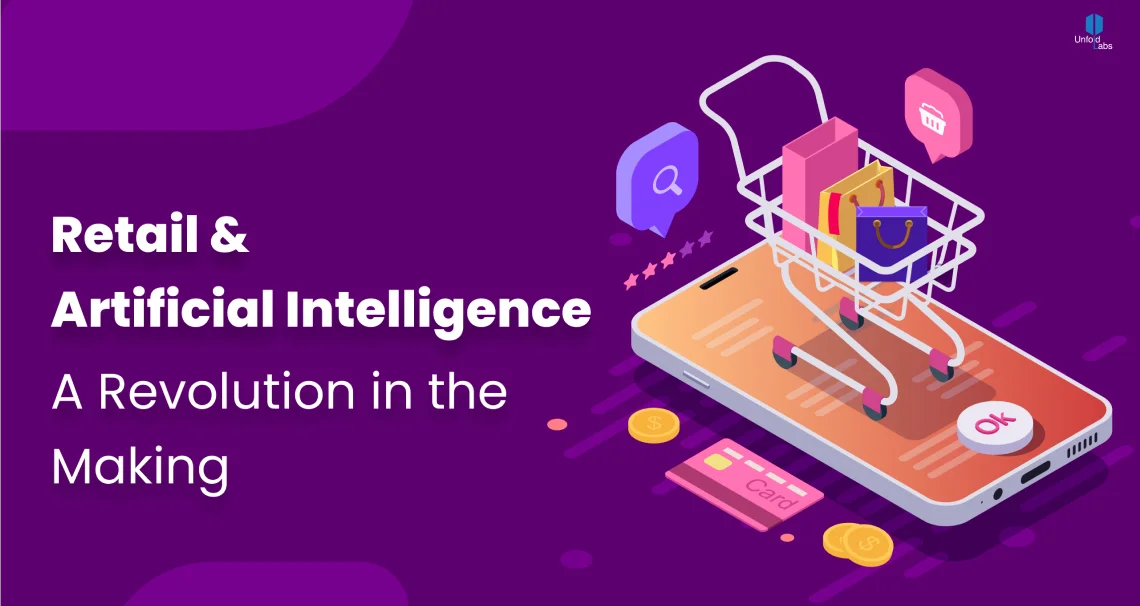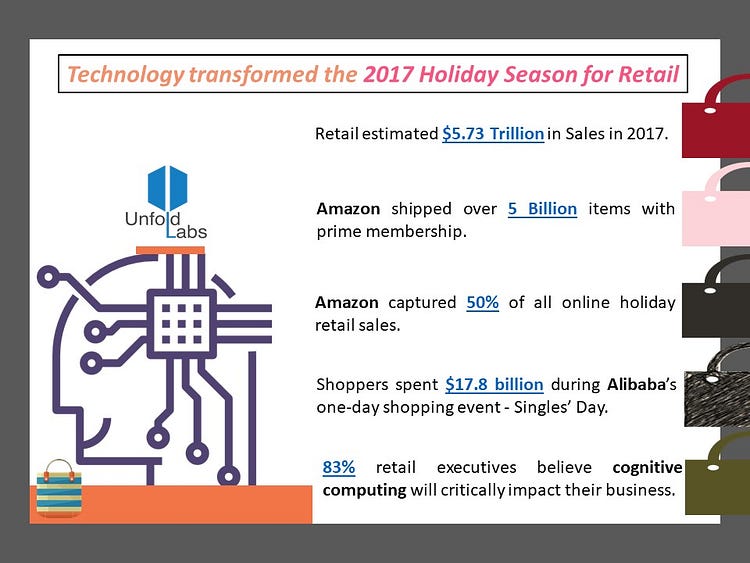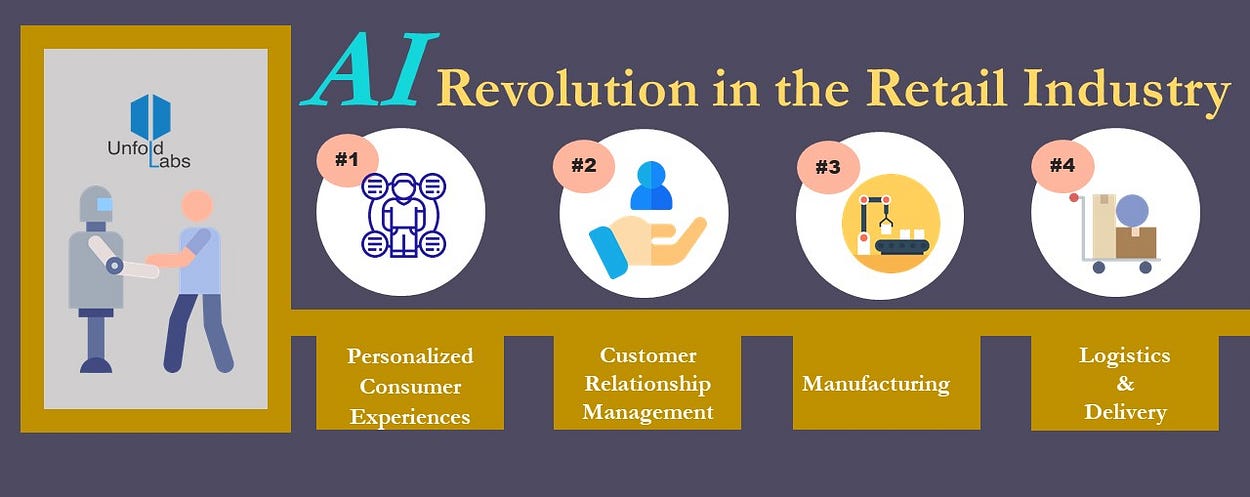Retail & Artificial Intelligence - A Revolution in the Making

Retail, one of the largest industries in the world, totaled an estimated $5.73 trillion in sales in 2017 in the US according to Plunkett Research. This is an increase compared to the $5.52 trillion in sales in 2016 according to the U.S Census Bureau. With the help of artificial intelligence, consumers are experiencing a whole new way of shopping both online and in stores. AI in retail is being applied in innovative ways - from before a sale to after products or services is purchased.

Businesses of tomorrow must keep up with customer expectations and implementing AI can help. The role of AI in the retail sector is transforming the industry through various new techniques that are being used. In IBM's survey, 91% of retail executives said that they believe cognitive computing will play a disruptive role in the industry, and 83% believe it will have a critical impact on the future of their businesses. It is pertinent for retailers to use AI to their advantage to stay ahead of competition, increase sales and gain customer loyalty.

AI Revolution #1 in Retail - Personalized Consumer Experiences
Personalized consumer experiences are used to drive sales and to get repeat customers. AI is helping to revolutionize the way businesses are reaching consumers by integrating advanced digital technologies, such as gathering data on purchase history, using Chatbots to automate responses that mimic human interaction, and creating retail experiences. Consumer personalization is an innovative way of reaching out to shoppers who want a relevant shopping experience.
48% of customers believe in the importance of providing on-demand personalized promotions online & 45% of customers want the same options in store.
Customers also want to discover and purchase products however, whenever and wherever they want and are assuming ever-greater ownership over their retail journeys.
Here are some areas where AI is helping with personalized experiences:
- ChatBot Experiences - Chatbots are helping companies engage with customers by enabling 24-hour customer service and personalizing recommendations.
- Conversational Interfaces - Conversational interfaces like using Amazon Echo or Google Home enable users to perform a task, like asking about certain products by speaking a command. AI Technologies like Natural Language Understanding allows customers to speak to a machine to get answers to questions about products, to purchase items online, or to autocomplete a search query.
- Digital Wearable Experiences aka Virtual Mirrors - UNIQLO allows customers to "try on" clothing to see what a jacket would look like in different colors using Holition's Magic Mirror technology. ModiFace's AR technology is a mirror that allows MAC Cosmetics' customers to virtually try different makeup looks in real-time.
- Machine Learning - Through machine learning, companies can provide customers with a more personalized shopping experience by suggesting relevant products or deals which are learned from the past shopping habits of customers.
- Experiential-based retail model - Also known as "retailtainment," this is an experience that combines entertainment and technology with traditional shopping. Examples include pop-up stores, live events, live product demonstrations, augmented reality jewelry counters and dressing rooms, and interactive high-tech mannequins.
- Gеѕturе Recognition - can personalize shopping experiences by capturing gestures that are translated into commands using touchless computer monitors so shoppers can find the exact items that they are looking for.
- Robots to increase foot traffic - Humanoid robots that can chat with customers, answer questions and give directions are being used to increase foot traffic in stores to increase revenue.
- Automated Cash Registers - Automated self-checkout lanes, seen mostly in supermarkets and large retailers like Home Depot have helped to speed up the checkout process and saves on labor costs.
Retailers need to personalize experiences to meet the demands of consumers who today, more than ever, are more informed about products. User experience should engage customers in a way that encourages them to make a purchase because it is marketed specifically to them. Moreover, experiences that are personalized shows consumers that a brand understands their needs and wants and catering to their specific needs means providing the best possible customer service and oftentimes, knowing what the consumer needs and wants before they do.
AI Revolution #2 in Retail - Customer Relationship Management
Customer Relationship Management (CRM) systems require data to enable to create customer-focused experiences and strategies. Useful customer data can provide valuable information on customers to create a marketing plan, provide valuable information that can shorten sales cycles and automate marketing to customers.
Traditional business intelligence and analytics gleaned from transactional systems helps in retail. Business intelligence and analytics, which can track sales, inventory and marketing promotions, benefits companies in many ways. Retailers can gain a better understanding of key metrics, extract the most useful information, obtain revenue-driving insights, predict future performance, make faster and smarter decisions, and even create self-service offerings.
Retailers are starting to use video analytics software to improve customer service and safety. The data gathered helps determine how customers engage with a product and how they navigate through a store. Surveillance findings is helping to improve the layout of the store for maximum exposure to products and possibly increase the time customers spend in a store. Moreover, video analytics will also be used to protect against security threats, including employees who do not comply with procedures.
Using connected AI platform to CRM Systems automate responses to handle basic customer queries. This helps businesses reduce issue escalation and customer complaints and improve consumer satisfaction.
Customer Relationship Management benefits businesses by improving interactions with current and potential customers. By analyzing data and interactions, companies can improve relationships with customers and prospects. Through an enhanced customer experience that includes customizing offerings and ensuring customer satisfaction, CRM aids in increasing customer retention and drives growth of sales. Implementing a CRM system is of utmost importance especially in today's highly competitive retail business where customers expect only the best customer service.
AI Revolution #3 in Retail - Manufacturing
Robots are helping the manufacturing industry through intelligent automation and are creating a new virtual workforce. This is being achieved through using warehouse robots alongside human workers and by using an AI platform to handle manufacturing and customer queries.
Robots, such as those used in Amazon fulfillment centers, are helping in manufacturing by taking care of the difficult tasks such as heavy lifting, pulling items from shelves, stocking shelves, and efficiently packing items. Likewise, cashiers are being replaced by smart sensors, resulting in less wasted time and materials, as well as optimal accuracy and workflow.
Production Quality without Human Errors: Improved Quality, Speed & Efficiency; Lower Costs, Quicker turnaround
According to the article in Forbes.com, "Top 5 Digital Transformation Trends In Manufacturing," smart factories with integrated IT systems, such as those that are able to collect information, perform skilled labor, and predict consumer behavior, increase production capacity by 20% by providing relevant data to both sides of the supply chain more easily. The article also states that, "sensors have replaced human hands resulting in less wasted time and materials" as well as optimal accuracy and workflow, lower production costs, faster turnarounds, and meeting customer demand more efficiently.
AI could boost US labor productivity by 35% by 2035.
An Accenture report, "Why Artificial Intelligence is the Future of Growth" predicts that by 2035, AI, which can allow people to make more efficient use of their time, could significantly boost US labor productivity by 35%.
AI is set to improving quality of goods in manufacturing, increase speed & efficiency of production and Lower Costs.
AI Revolution #4 in Retail - Logistics and Delivery
AI technologies in logistics and delivery have greatly improved and streamlined the way businesses are keeping track of everything from inventory to delivering packages. With today's technological advancements, it is now much simpler for businesses to manage inventory and to make on-demand deliveries as quickly and efficiently as possible. AI technologies are a cost-effective way to optimize and improve logistics and delivery.
- Inventory Management - AI is changing inventory management through optimization algorithms, resulting in the ability to keep up with supply and demand by reducing stock depletions and maximizing stock levels, prevention of costly facility malfunctions, and increasing ROI.
- Supply Chain - IBM's Watson Supply Chain uses cognitive learning capabilities to "provide supply chain visibility, transparency and insight into supply chain data and processes" by tracking and predicting supply chain disruptions. This is achieved by gathering and correlating external data from different sources like social media, for example.
-
Last mile delivery
- AI's role in last mile
delivery includes using:
- Drones to complete last-mile deliveries
- Autonomous vehicles to make deliveries
- Delivery trucks utilized as small distribution centers
- Small AI machines or droids to complete deliveries
Remote sensing, the Internet of Things (IoT), telematics, and geospatial mapping embed information into products and the vehicles transporting them - the origin, destination, journey, and recipients of goods. Therefore, the physical flow of materials across the supply chain leaves a trail of data which is a sweet spot for AI, which depends on large volumes of data to extract knowledge and learn through self-analysis.
Staying ahead in delivering the goods and services is the key to success in retail, and hence taking informed decisions for logistics along with studying the data-patterns is very important. Retail logistics can predict the demand, eradicate the shipment delay, plan and align the operations well in advance by leveraging Big Data and AI.
Amazon seems to understand the need for AI in logistics and hence Next-generation logistics is a centerpiece of Amazon's R&D. Nearly 80 of Amazon's 2016 patents are focused on developing its logistics network, and Amazon also patents heavily for its cloud computing and cybersecurity efforts.
Our Take on AI for Retail
The retail industry has boomed in the past few years due to technology advancements. AI is providing a breakthrough for retail leaders like Amazon who have innovated with AI. Efficiency has improved over the years and much more personalized experiences are coming into the fray.
Companies have been using machine learning to offer customers unique experiences. With the increased closures of brick-and-mortar stores, AI will need continue to evolve to meet the demand of shoppers who are now making most of their purchases through e-commerce sites. Furthermore, to be able to compete with retail giants like Amazon and WalMart, businesses must use the power of AI to know and understand their customers to create personalized experiences. Implementing and keeping up with AI technologies in today's dynamic retail industry will allow businesses to cater to consumer expectations and drive sales.